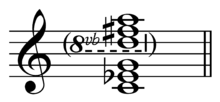Bridge chord
For transitional harmony, see Modulation (music).
| Component intervals from root | |
|---|---|
| major sixth | |
| fifth | |
| tritone | |
| minor third | |
| major second | |
| root | |
| Tuning | |
| 32:36:38:45:48:54 | |
| Forte no. / | |
|
6-z29 / |

Bridge chord on C  Play .
Play .
The Bridge chord is a bitonal chord named after its use in the music of composer Frank Bridge (1879–1941). It consists of a minor chord with the major chord a whole tone above (CE♭G & DF♯A),[1][2] as well as a major chord with the minor chord a semitone above (CEG & D♭F♭A♭), which share the same mediant (E/F♭).[1][3] (![]() Play ) Both form eleventh chords under inversion (DF♯ACE♭G = D11♭9 and D♭F♭A♭CEG = D♭mM7A9A11).
Play ) Both form eleventh chords under inversion (DF♯ACE♭G = D11♭9 and D♭F♭A♭CEG = D♭mM7A9A11).
Bridge had strong pacifist convictions, and he was deeply disturbed by the First World War, after which his compositions, beginning in 1921–24 with the Piano Sonata, were marked by a radical change in musical language.[4] The Bridge chord is fairly dissonant, containing seconds as well as two tritones.
See also
References
- 1 2 Payne, Anthony; Foreman, Lewis; and Bishop, John (1976). The Music of Frank Bridge, p.42. Thames Publishing. ISBN 9780905210025.
- ↑ Mark Thornton Burnett, Adrian Streete, and Ramona Wray, eds. (2011). The Edinburgh Companion to Shakespeare and the Arts, p.174. Edinburgh University Press. ISBN 9780748635238.
- ↑ Hold, Trevor (2005). Parry to Finzi: Twenty English Song-composers, p.180. Boydell Press. ISBN 9781843831747.
- ↑ Payne, Anthony, Paul Hindmarsh, and Lewis Foreman. 2001. "Bridge, Frank". The New Grove Dictionary of Music and Musicians, second edition, edited by Stanley Sadie and John Tyrrell. London: Macmillan Publishers.
This article is issued from Wikipedia - version of the 7/11/2014. The text is available under the Creative Commons Attribution/Share Alike but additional terms may apply for the media files.